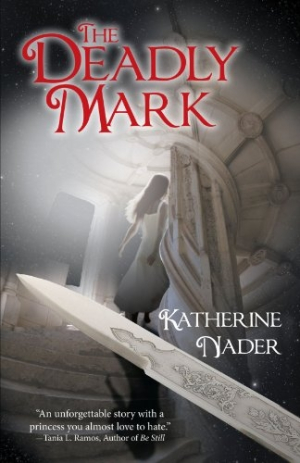
The Deadly Mark
Princess Kathleen has a destiny to fulfill. As heiress to the throne, she must marry well and prepare to rule her kingdom. Her reluctance to embrace neither an arranged marriage nor the kingdom sets her at odds with the power-hungry men around her in The Deadly Mark.
Set in 1821, The Deadly Mark has an interesting premise complete with well-kept secrets, political machinations, a damsel in distress, and a man willing to risk his life to keep her safe. Princess Kathleen becomes a pawn in a struggle for power, and even her father, King Rene IV, is more concerned with maintaining political control than with his daughter’s well-being. As Kathleen’s life is endangered by the actions of others, as well as her own increasingly self-destructive behavior, the king assigns a guardsman named Eden to protect her, not realizing that Eden’s allegiance to Kathleen will soon supersede his allegiance to his king.
Katherine Nader sets the beginning of her tale during a most desperate moment for Kathleen. Kept prisoner by a mysterious man, her life is clearly in grave and immediate danger, and the tense opening scene will draw readers into the story and also inspire empathy for the heroine. Such sympathetic feeling is dispelled fairly quickly, however, as Kathleen reveals herself to be selfish and one-dimensional as the story progresses.
While Nader makes the effort to capture early-nineteenth-century atmosphere and dialect, occasional anachronistic references and dialogue hamper the attempt. Much of the novel’s intrigue remains slightly vague and lost in muddled phrasing. Though the story structure itself is relatively sound, ineffective sentence construction and poor word choice lead to confusion, such as in this line: “After a few dour methods to go back to sleep furiously for five minutes, Kathleen got up, washed her face, and opened the door.” Incorrect phrasing often makes the reading difficult, as evidenced in the following sentence: “Eden looked for her voice, as the wind carried the familiar smell of blood that pounded in his ears.” While readers are likely to discern the meaning of such sentences, doing so will require extra effort.
Characterization is adequate, although readers are apt to find themselves wishing that they knew more about the main character. As it stands, Kathleen’s personality is not developed with enough depth to explain her self-absorption. Her situation inspires sympathy, but her often cruel and dismissive rejection of nearly all who show concern for her lessens the impact of her circumstances. Eden, her brave and curiously devoted guardian, proves far more interesting and easy to root for.
The Deadly Mark contains several interesting elements, and the author leaves a thread that could easily lead to a sequel. The often confusing writing style could be overcome with editorial assistance. More difficult to overcome is the less than sympathetic heroine, whose general abrasiveness may result in a lack of reader engagement. If Kathleen’s character were given as much depth as Eden’s, readers would likely feel more satisfied and affected by the conclusion of The Deadly Mark.
Reviewed by
Jeannine Chartier Hanscom
Disclosure: This article is not an endorsement, but a review. The publisher of this book provided free copies of the book and paid a small fee to have their book reviewed by a professional reviewer. Foreword Reviews and Clarion Reviews make no guarantee that the publisher will receive a positive review. Foreword Magazine, Inc. is disclosing this in accordance with the Federal Trade Commission’s 16 CFR, Part 255.
